
João Alexandre Paschoalin Filho - E-mail: jalexandre@uni9.pro.br, Orcid: https://orcid.org/0000-0001-7356-0779
Daniela Belchior Brito - E-mail: daniela.belchior@gmail.com, Orcid: https://orcid.org/0000-0002-1273-3442
John Fredy Lopéz-Pérez - E-mail: jflopez@udem.edu.co, Orcid: https://orcid.org/0000-0002-1372-6252
António José Guerner Dias - E-mail: agdias@fc.up.pt, Orcid: https://orcid.org/0000-0002-1848-2234
Abstract
COVID-19 affected the habits of populations: work, study, mobility, and interpersonal relationships and highlighted social differences hitherto ignored. In general, governments have been taking actions to combat the pandemic and mitigate the speed of contamination. However, in many cases, these actions are disconnected from the population. Within this context, this article aims to demonstrate the view of the inhabitants of São Paulo and Medellín about the effectiveness of actions carried out by municipal governments to identify situations in common and contrasts. To this end, a multiple case study was conducted in which citizens were interviewed. Then, the interviews were transcribed and analyzed. The vision of the population impacted by the pandemic is essential for evaluating public policies in progress and planning actions to guarantee cities' resilience concerning the established crisis.
Keywords: COVID-19. Urban planning. Urban resilience. Collective Health.
Resumo
A COVID-19 afetou os hábitos das populações: trabalho, estudo, mobilidade e relações interpessoais, tornando mais evidente as diferenças sociais. De uma forma geral, os governos vêm tomando ações no intuito de combater a pandemia e mitigar a velocidade de contaminação. Todavia, em muitos casos, estas ações têm se demonstrado desconectadas com a população. Dentro deste contexto, este artigo tem por intuito demonstrar a visão dos habitantes de São Paulo e Medellín acerca da efetividade das ações conduzidas pelos governos municipais, a fim de identificar situações em comum e contrastes. Para tal, foi conduzido um estudo de casos múltiplos em que munícipes foram entrevistados. Em seguida, as entrevistas foram transcritas e analisadas. A visão da população impactada pela pandemia é importante para a avaliação de políticas públicas em andamento e para o planejamento das ações a serem tomadas, de forma a garantir a resiliência das cidades em relação à crise estabelecida.
Palavras-chave: COVID-19. Planejamento urbano. Resiliência urbana. Saúde Coletiva
The pandemic caused by COVID-19 was confirmed by the World Health Organization on March 11th, 2020 (ZHONG et al., 2020). Furthermore, Maciel, Silva, and Farias (2020) declared that COVID-19 was responsible for a public health services overload in many countries, independent of their development conditions.
The pandemic resulted in more than 626,030,881 confirmed cases, 6,751,803 deaths, and more than 12 billion vaccine shots given worldwide until 10/10/2022, as noticed by the John Hopkins Coronavirus Research Center website (2022).
The disease is highly contagious, and its main symptoms are dry cough, fatigue, fever, myalgia, and dyspnoea (ZHONG et al., 2020). However, according to Guimarães et al. (2020), the new coronavírus pandemic can not be considered a usual public health problem due to the new obstacles imposed by the disease in a globalized world.
Since the pandemic was declared, the scientific community has tried to bring light on the mechanisms that boost the vírus spreading and its environmental and socioeconomic impacts. Desai (2020) realizes that many researchers have been working to explore the pandemic dynamics in urban areas intending to understand the COVID-19 impacts on the cities. To the author, the public policies taken to face the pandemic can differ from one context to another, and it is not even possible to take the same procedures to different places. Desai (2020) states that as bigger the city is, as much higher the susceptibility to the virus spreading.
However, it is a truth that the pandemic also can provide opportunities for the development, assessment, and application of public policies headed to crisis management, intending to bring more quality to the urban environment and social well-being (KUMMITHA; CRUTZEN, 2017, JAMES; JALISINSKA; SMITH, 2020).
In addition, the development of many intelligent cities once people's daily routines have been changed by the increasing preference for telecommuting, telemedicine, e-commerce, and e-learning can be expected. Furthermore, Banais (2020) declares that the pandemic can simultaneously show the cities' vulnerability and resilience straightforwardly. This way, the pandemic can bring essential changes in urban planning worldwide.
So, the question that has led to this research was: What is the population's view about the influence of the COVID-19 pandemic on the routine of their cities? This question is essential to bring to light how the pandemic has harmed the cities and how the social differences have been evidenced in cities that can be pointed out by their economic and political relevance, besides their overcrowding.
Facing it, this paper has an essential role in framing how the populations have felt the changes brought about by the pandemic, considering the job market, education and social relationships, and public urban mobility.
To get the necessary information for the research, the citizens of São Paulo (Brazil) and Medellín (Colombia) were interviewed, and after that, their responses were compared with each other. The reason for choosing these two cities lies in their economic and political relevance in Latin America and because both places have been dealing with the same social and Governance problems. The interviews were led to investigate the lifted research question and were analyzed using the software Iramuteq.
The first case of COVID-19 in São Paulo (Brazil) was recorded on February 25th, 2020, at a private hospital. Since then, the State Government has closed schools, universities, shops, and restaurants. In addition, public agencies reduced their activities, while many companies have sent their employee for home officing (OLIVEIRA ANDRADE, 2020). In São Paulo, until 03/10/2022, about 1.04 million COVID-19 cases and more than 41.8 thousand deaths were recorded. However, until this date, more than 29 million cases and 653 thousand deaths have been accounted for in Brazil.
Among the procedures taken to reduce the contagion between people, public policies dealt with the social distance in different ways, confusing the population and decreasing the effect of this procedure. This situation was highlighted by Pereira et al. (2020). The authors found a lack of straight coordination by the federal government and the excess rigor by state and municipal governments were more headed by political issues than technical and health ones.
This lack of matching between government levels, as stated by Pereira et al. (2020), contributed to the population's suspicion about the actions taken during the pandemic. Storopoli et al. (2020) figured out that the population's adherence to the preventive measures put in force by the government was highly influenced by the population's trust in governmental agencies.
Although the adverse effects brought by the pandemics, such as economic recession, public health system overcharge, a significant amount of deaths, and population impoverishment, some problems in São Paulo have been softened. According to Deboni et al. (2020), air pollution decreased significantly by 90 days, improving air quality. Furthermore, due to the pollution dropping, the city spared about US$ 720 million that would be spent on public health facilities for healing diseases caused by air pollution.
The pandemic also encouraged the use of technological tools by government agencies and the population. For example, Schreiber (2020) reports that the stated government partnered with a cell phone company intending to follow the social distancing measures efficiency and analyze the population's adherence to the restrictions procedures taken into force by the government.
De Lima and Tumbo (2021) comment that all education levels (elementary, high school, and college) had to be adapted to be offered on the internet by e-learning platforms. However, according to the authors, although the internet has made possible use of new educational tools and resources, a significant student population's amount was excluded because of their difficulties accessing the internet.
The job market also suffered significant changes due to the pandemic. For example, many companies have allowed their employee to perform their duties at home (home officing). In addition, to De Lima and Tumbo (2021), this situation improved the city's traffic conditions. It was also pointed out as one of the factors that increased air quality and reduced atmospheric pollution. Moreover, as stated by Andion (2020), many solidarity initiatives were taken by civil society during the pandemic.
Nevertheless, Cardenas et al. (2020) report that the social crisis caused by the pandemic in Latin American countries has the potential to increase economic inequality because of the lower social welfare rates, weakened public health systems, informal job's raising, inequality in technological facilities access and difficulties to save money. Furthermore, the authors also highlight the Latin American money fragilities that can lead to inflation and economic instability, turning much challenging the adoption of policies straight to income distribution to the poorest population and the increase in the number of social investments.
The city of Medellín is the second biggest city in Colombia and has 2,5 million inhabitants, as informed by Medellín's government (2021). The metropolitan área of Medellín is composed of nine cities, which increase the number of inhabitants to more than four million. The metropolitan area of Medellín corresponds to 60% of Antióquia province's population.
The social changes that have taken place over the last two decades in Medellín have led to urban modernization and social transformation, including the poorest people into public policies as urban mobility, educational issues, public health and education, entrepreneurship, and technological innovation, implementation of public pieces of equipment for cultural events and leisure (TRINDADE et al., 2017).
In Medellin’s slums, almost all the population lives under poverty conditions. Nevertheless, informal job levels can reach 50% (ORTIZ et al., 2018). Concerning the public water supply system, to make it possible for the slum population to have access to clean and potable water, Non-Governmental Organizations have pushed the municipal government to support new and non-profitable enterprises for providing water to the poor people (MOLINA-BETANCURO et al., 2020).
In Colombia, on March 6th, 2020, the COVID-19 case was confirmed in Bogotá (LARA; CRUZ, 2021). According to the measurements done by Medellín's government, until March 3rd, 2022, the city has reached more than 523,227 COVID-19 confirmed cases and almost 10,041 deaths (with a recovery rate of 98% and 1.92 of lethality). During the same period, 6,07 million cases and 135 thousand of deaths were recorded in Colombia.
Molina-Betancur et al. (2020) state that Medellín suffered from economic difficulties and little help from the federal government and other institutions. However, the organized population of many communities responded effectively to this situation, intended to keep the pandemic under control. However, according to the authors, wondering a post-pandemic scenario, the communities will have to face social and economic reactivation due to the decaying social conditions. Furthermore, these communities also have to face the multiple social and psychological consequences caused by COVID-19, besides new pandemic waves.
The quarantine was used worldwide, intending to stop the coronavirus from spreading. However, in Colombia, the quarantine prohibited people from making their way freely across the cities and became mandatory for the population to stay home. In addition, only basic goods productions and essential services were permitted. However, the restrictions were not imposed on workers' mobility, health professionals, basic sanitation, and emergency services. Furthermore, Salamanca and Vargas (2020) report that the financial help given by the Colombian government to the population was not enough for some families, which made the adhesion of low-income populations complex during the lockdown.
According to Corburn et al. (2020), low-income countries suffer more from pandemic impacts. In addition, the authors also highlight that low-income countries are not prepared enough to face the crisis caused by COVID-19 once the primary population's needs as garbage collecting, housing, basic sanitation, etc., are still scarce. Furthermore, the restrictions, the violence, and the poor communities' overcrowding have made quarantine and physical distancing impossible.
The Colombian high unemployment rate, as stated by Lara and Cruz (2021), points out that the policies taken by the government to protect the jobs and micro and small companies have not been able to mitigate the crisis’ effect on the job market due to the pandemic.
To give support to the entrepreneurs, the Colombian government took into force Law 2088/2021, which becomes legal the home-officing as it frames in the following conditions: occasional, exceptional, and unique situations, any kind of job under federal regulations and legislation (public or private) (LARA; CRUZ, 2021). Besides, the results from the social isolation could be felt in Medellín, where only 19% of the companies stood operating normally. Concerning the labor force, only 18% of it remained in their jobs (MEDELLÍN, 2020).
Molina-Betancur et al. (2020) highlight the essential role of the community media in Medellín (radio, websites, youtube, etc.), broadcasting information about hygiene, public health, COVID-19 prevention, etc. As reported by the author, spaces were created in different communities that encouraged creativity, knowledge dialogue, debates, and reflection by young people and leaders, not only around the imminent nature of the crisis generated by the pandemic but also discussions about the future of these territories in a post-pandemic situation.
This chapter presents the methodological procedures taken in this research for obtaining the necessary data. The following Chart presents the procedures to meet the research's main objectives.
Chart 1 – Methodological Matrix
|
Methodological Matrix |
||
|
Analysis methodology |
Qualitative |
Taquette and Borges (2021) |
|
Methodological approach |
Exploratory |
Mathias-Pereira (2016), Gil (2002) |
|
Methodology |
Multiple cases study |
Yin (2017), Gil (2002) |
|
Cell of analysis |
Socioeconomic effects generated by the new coronavirus pandemic in different locations. |
Kummitha e Crutzen (2017), James et al. (2020), Banai (2020)
|
|
Data collection procedures |
Theoretical reviewing and interviews performed.
|
Gil (2002), Pereira et al. (2018) |
|
Data collection tool |
Semi-structured interview script |
Gil (2002), Pereira et al. (2018), Yin (2017) |
|
Data analysis methodology |
Content analysis, data triangulation |
Gil (2002), Pereira et al. (2018), Yin (2017), Franco (2020) |
Source: The Authors
A script of 9 questions divided into three thematic axes was prepared to conduct the interviews: a) socioeconomic, b) management, and c) urban space. The questions and the references used to formulate them are presented in Chart 2.
Chart 2 – Questions used in the research script in each axis.
|
Socioeconomic Effects of the Pandemic — COVID-19 |
|||
|
Axis 1: Socioeconomic |
1 |
What changes have you had to adopt concerning your daily life and that of your family members since the imposed restriction measures, and which changes do you believe will remain after the pandemic? |
Bachman (2020). |
|
2 |
Regarding education and work, what is your perception of how the pandemic is affecting these two areas? |
Lara and Cruz (2021) |
|
|
3 |
How do you evaluate the current economic situation in the country since the pandemic was declared in March 2020, and what are your perspectives for the future (up to 2 years from now)? |
Sharif e Khavarian-Garmsir (2020) |
|
|
Axis 2: Public Management |
4 |
What is your opinion about the performance of government officials (federal, state, municipal) concerning the fight against the pandemic? |
Sharif and Khavarian-Garmsir (2020) |
|
5 |
One of the measures governments are taking to combat the pandemic is closing bars, restaurants, and businesses. How do you evaluate the effectiveness of this measure? |
Rajan et al. (2020), Iwuoha e Aniche, (2020) |
|
|
6 |
How do you evaluate the vaccination program being carried out by the government where you live? |
Velavan and Meyer (2020) |
|
|
Axis 3: Urban Space |
7 |
How did you behave in the face of the imposed restriction measures? Also, describe your perception of these rules. |
Salamanca and Vargas (2020) |
|
8 |
How do you evaluate government policies regarding urban mobility during a pandemic (public transport, vehicle rotation, flight restrictions, etc.)? |
Cartenì et al. (2020) |
|
|
9 |
How do you evaluate the government's action in preventing the use of parks and other public leisure areas as an action to combat the COVID-19 pandemic? |
Ezeibe et al. (2020) |
|
Source: The Authors
The citizens of São Paulo and Medellín were interviewed about everyday issues to observe their habits, concerns, and expectations during the COVID-19 pandemic. For Yin (2017), direct observations are essential precisely because they seek evidence. Through them, one comes into contact with the phenomenon under study. The respondents authorized the interviews under conditions that did not inflict any possibility of risk or harm. Therefore, the interviews were conducted under Article 1 of Resolution 510/2016; it is not necessary to submit the project of this research, as well as the data collection tool, for consideration by the Ethics Committee since all information, both of the agents interviewed, were kept confidential (BRASIL, 2016).
For the interpretation of the collected information, the recordings were transcribed for Content Analysis (FRANCO, 2020), a qualitative methodology that analyzes the answers provided by the interviewees, providing a deepening and greater understanding of the investigated themes. Among the various qualitative research approaches, Content Analysis is the one that best enables answers to research questions, as it allows a broad understanding of the phenomenon in question. Once transcribed, the contents of the interviews were analyzed using the Iramuteq software. The analyzes processed were the following: a) Basic Lexicography - classic textual statistics, b) Descending Hierarchical Classification (CHD), and c) Similarity Analysis.
In total, there were interviewed 39 citizens; the age range considering the studied population is presented below:
Figure 1 - Age range of respondents in the city of São Paulo

Source: The Authors
Figure 2 – Gender distribution of the studied population.
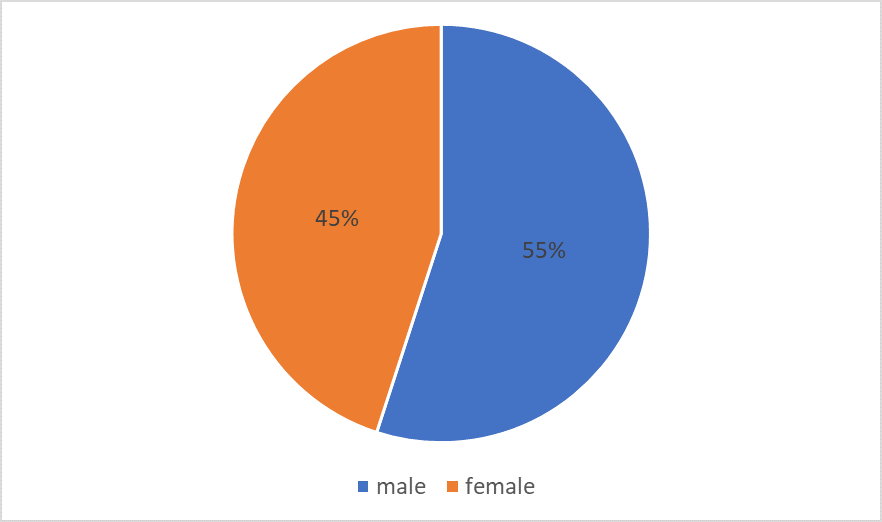
Source: The Authors
Figure 3 – Educational level distribution of the studied population.

Source: The Authors
During the period in which the interviews were performed, 56.4% of the interviewees had already been infected with the new coronavirus or had close family members infected with it, which led to 97.4% of the citizens intending to be vaccinated since, in this period, there was still there were uncertainties and unavailability regarding vaccination. Furthermore, regarding the interviewees' education, 89.7% declared having a technical level or higher.
Figure 4 presents the most frequently cited words in each of the axes studied:
Figure 4 - Most repeated representative words in the content of each axis according to respondents in São Paulo.
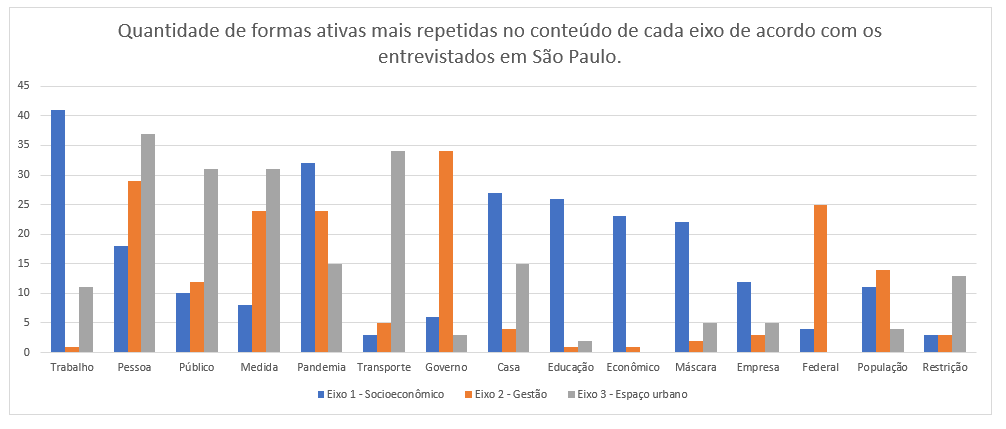
Source: The Authors
According to Figure 4, “work” was the most repeated (41 times) in the socioeconomic axis. In contrast, in the management axis, there was a higher incidence of the word “government” (34 times), and in the urban space axis, the word that most turned out to be “person” (37 repetitions). The words “pandemic,” “measure (in the sense of action taken),” and “house” are pretty present in the textual corpus, varying the repetitions according to the axes.
In processing the corpus, 306 text segments were classified, of which 208 were used, that is, 67.97%. According to Souza et al. (2018), using more than 60% of the segments leads to good representativeness, resulting in a statistically significant analysis. The text segments used were divided into classes and organized using the following dendrogram:
Figure 5- Dendrogram with the percentage of text segment in each class and words with the highest chi-square in the analysis of São Paulo.
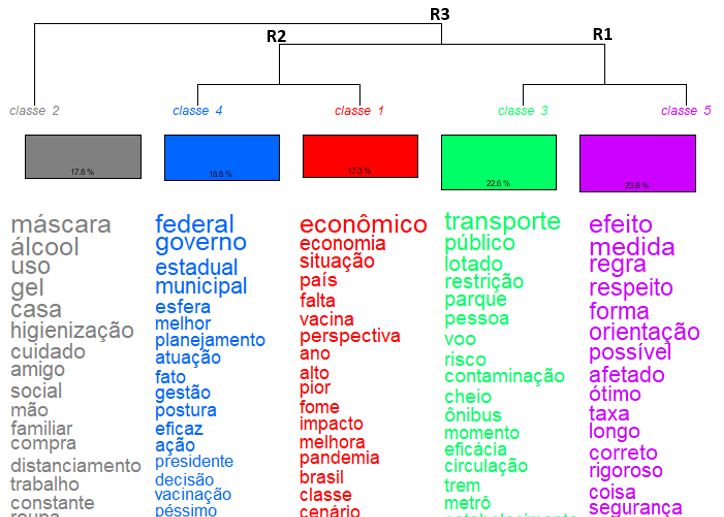
Source: The Authors
The R1 ratio is formed by classes 3 and 5 (totaling 46.16% of the analyzed segments). The most important words (represented in larger size) were: “transport (transporte),” “effect (efeito),” “public (público),” “measure (medida),” “crowded (lotado),” “rule (regra),” “restriction (restrição),” “respect (respeito),” “park (parque),” “orientation (orientação)” and “person (pessoa)." These classes refer to axes 2 and 3 of the interview script. Thus, R1 can be named: "Concern with restriction measures and urban mobility."
The R2 relation is characterized by classes 4 and 1 (totaling 36.06% of the analyzed segments). The most powerful words were: “federal,” “government (governo),” “state (estado),” “municipal,” “planning (planejamento),” “economic (econômico),” “situation (situação),” “vaccine (vacina),” and “perspective (perspectiva)." Thus, this relationship can be called: the "Impact of government decisions in combating the disease." About R3, it is observed that class 2 is more isolated concerning the others, demonstrating a relationship with all the others and with a representativeness of 17.31% of the analyzed segments. With the representation of the words "mask (máscara),” “alcohol (álcool)," "gel," "hygiene (higiene)," "care (cuidado),” and “distancing (distanciamento)," for example, the class is characterized by demonstrating the importance of personal care in combating contamination; These precautions apply to all axes analyzed through the sum of the R1 and R2 relations. Therefore, this relationship can be called: “Individual responsibilities in combating the pandemic.” Chart 3 summarizes the information obtained through the dendrogram in Figure 3.
Chart 3 - Summary of the analysis of the speeches obtained
|
Relations |
Classes |
The central theme identified in the speech. |
|
R1 |
5 e 3 |
Concerns with restriction measures and the situation in urban mobility |
|
R2 |
4 e 1 |
Impacts of government decisions in combating the pandemic in everyday life |
|
R3 |
2+R1+R2 |
Individual responsibility in combating the pandemic. |
Source: The Authors
The similarity chart presents text segments grouped so that they have relationships with each other. The larger the word size, the more significant it is in the delimited area. The links between the words also bring an idea of the strength of the relationship between them; the thicker the link, the more strength it has. Next, the similarity analysis obtained for the corpus under study is presented.
Figure 6 - Similarity obtained for the corpus under study in the analysis of São Paulo.
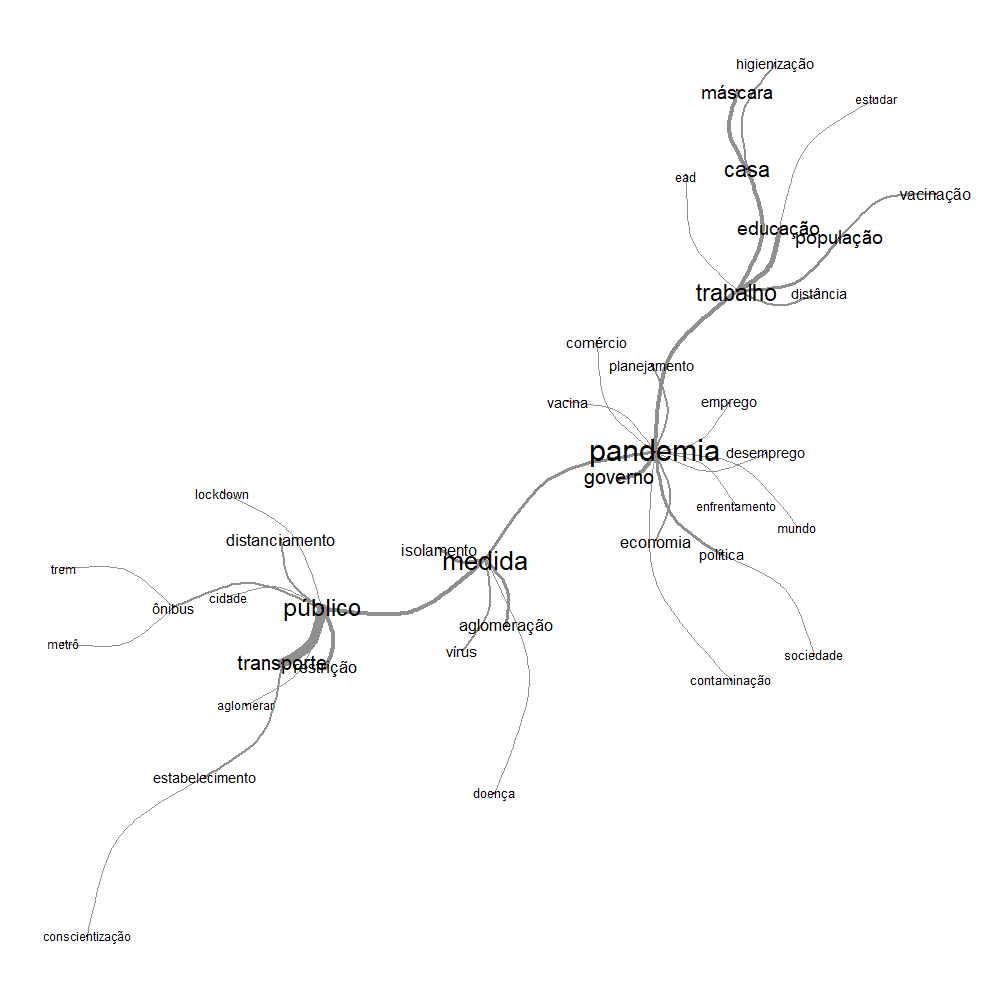
Source: The Authors
As shown in Figure 6, it can be seen that the words "pandemic (pandemia)," "measure (medida)," and "public (público)" are the most prominent. To the right of the graph, with a solid connection to the central axis, is a pole with "work (trabalho)" as the centralizing word. From this, there are developments in: "population (população)," "vaccination (vacinação)," "education (educação)," "study (estudo)," "home (casa)", "mask (máscara)," "hygiene (higiene)," "distance (distância)," and "EaD." In these relationships, it is vital to highlight the challenge to the continuity of activities remotely, both for companies and educational institutions. In this sense, the interviewees spoke about the concern about future schooling and families that do not have technological resources to support the adaptation to the remote modality. It is observed that there is a thick line of connection between "work (trabalho)" and "home (casa)" and "education (educação)," demonstrating the strong presence of remote activities.
The branch from "pandemic (pandemia)" relates mainly to "government (governo)." The other relations are: "vaccine (vacina)," "planning (planejamento)," "trade (comércio)," "employment (emprego)," "unemployment (desemprego)," "economy (economia)," "contamination (contaminação)," "politics (políticas)," and "society (sociedade)." These relationships demonstrate the effects on the economy and the responsibility of governments.
Still, in the central part of this graph, the word "measure (medida)" is related to demonstrating the effects of the measures adopted by the Brazilian government for families, represented by the words "isolation (isolamento)," "agglomeration (aglomeração)," virus (vírus)," and "disease (doença)." This analysis points to the speeches that indicated the unwanted effects resulting from the adopted measures, leading to more significant concern with contamination.
The words that relate to "public (público)" indicate the problems faced by transport during the period of restrictions. This indication can be observed through the relationship between the central axis of the "public (público)" halo and "transport (transporte)," followed by "aggregate (aglomeração)," "restriction (restrição)," and "awareness (conscientização)." In this analysis, there is a concern about contamination through crowds and the need to move for people who did not have the opportunity to remain in isolation. In this sense, the links "city (cidade)," "bus (ônibus)," "train (trem)," subway (metrô)," "distance (distância)," and "lockdown" exemplify the situations demonstrated.
The interview script was applied to residents of Medellín during April 2021, with 56 interviews being conducted. The following Figure demonstrates the age range of respondents:
Figure 7 - Age range of respondents in the city of Medellín
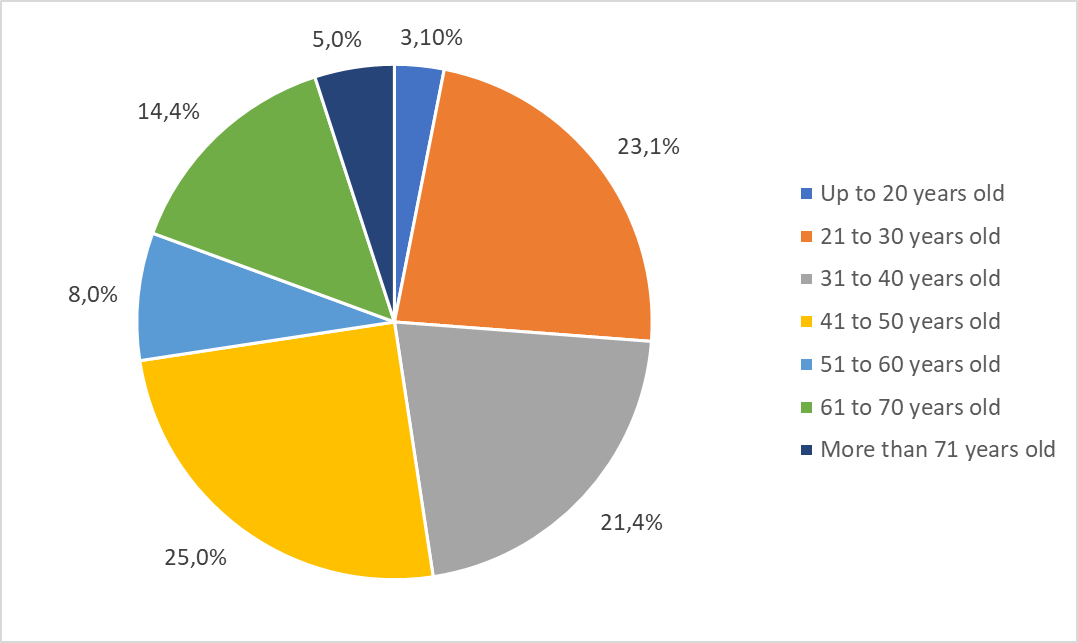
Source: The Authors
Figure 8 - Gender distribution of the studied population.
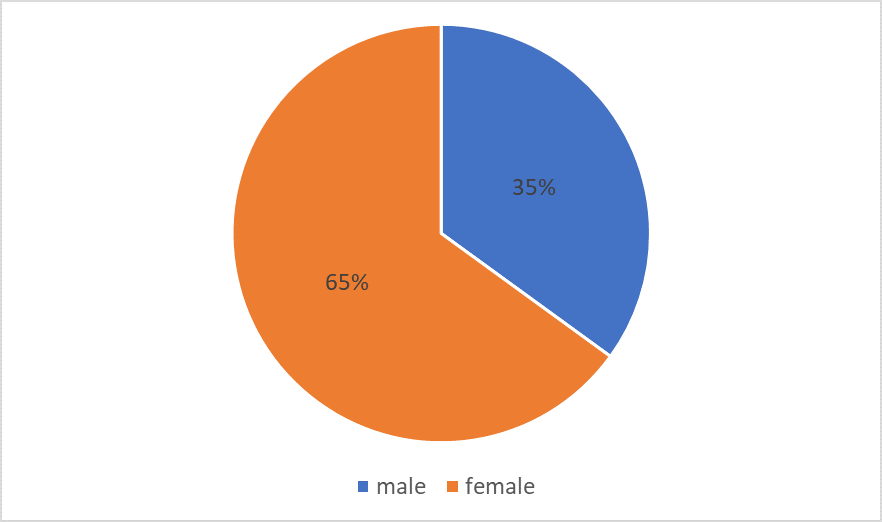
Source: The Authors
Figure 9 - Educational level distribution of the studied population.
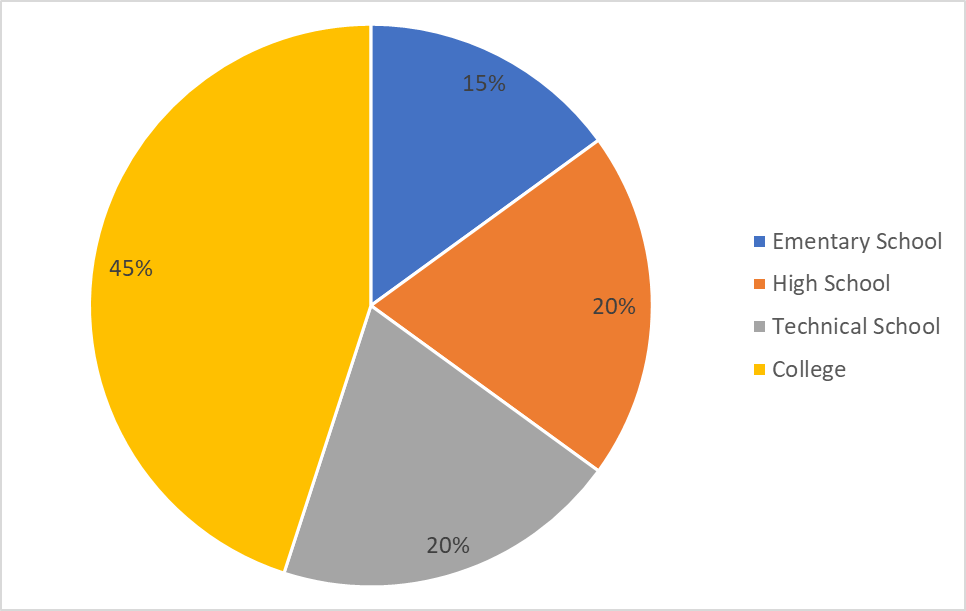
Source: The Authors
During the period in which the interview was applied, 75% of respondents had been infected by the new coronavirus or had close family members infected, which led to 83.9% of respondents intending to get vaccinated.
Figure 10 presents the most frequently cited words in each of the axes studied:
Figure 10 — Number of most repeated active forms in the content of each axis according to respondents in Medellin.
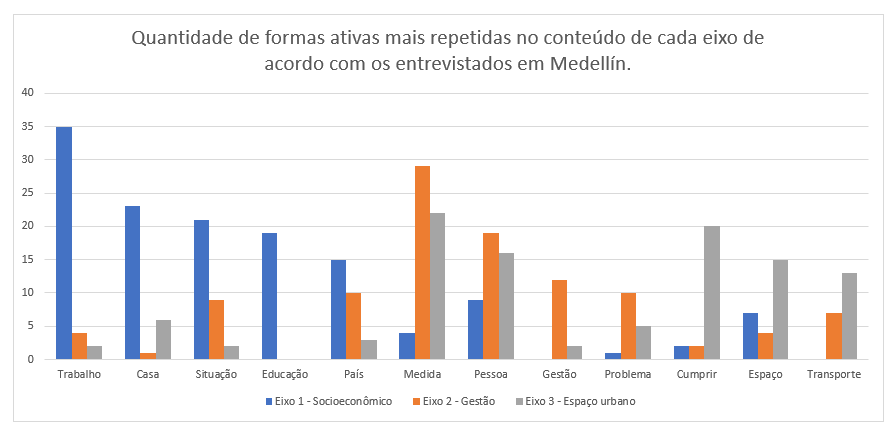
Source: The Authors
In this representation, it is observed that the words “measure (medida),” “country (país),” “person (pessoa),” “situation (situação),” and “space (espaço)" frequently appear in the three axes. On the other hand, the word "comply (cumprir)” is more present in axis 3 (urban space), related to compliance with the restriction rules imposed on public environments, and also appears in the other axes related to compliance with individual protection recommendations, such as the use of masks (mentions present in the axis 1); government determinations of social isolation and closure of establishments are dealt with in axis 2 (management). In axis 2, “measure (medida)” is related to “management (gestão)” in the indication of inequality and poor planning, in addition to the lack of inspection in compliance with the “measures,” arguments often cited in the interviews.
In processing texts, 306 text segments were classified, of which 208 were used (60.83%). The text segments used were divided into classes and organized using the following dendrogram:
Figure 11 — Dendrogram with the percentage of text segment in each class and words with the highest chi-square in the analysis of São Paulo.
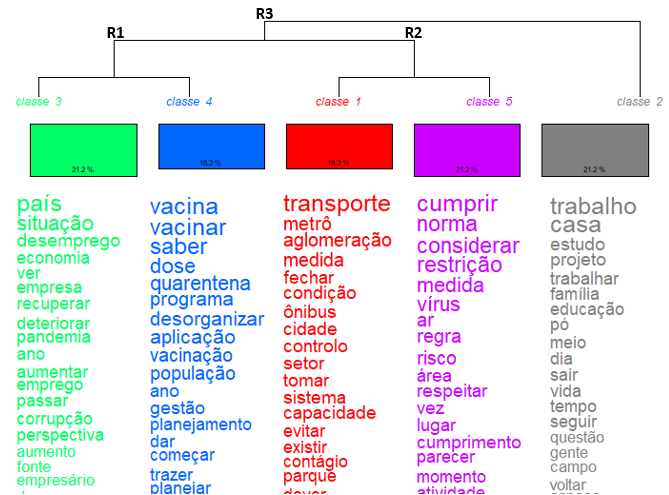
Source: The Authors
It can be seen that the dendrogram was divided into five classes. For a better analysis, Iramuteq demonstrates the relations (Rs) between R1, R2, and R3. The R1 and R2 relations represent 39.4% of the analyzed textual corpus; they total 78.8%, presenting equivalent significances and most of the content. R1 is the sum of the percentages of classes 3 and 4 (21.2% and 18.2%, respectively). Thus, in class 3, the analyzed segments demonstrate the economic situation generated by the pandemic through the respondents' statements. Class 4 (with 18.2%) is concerned about the vaccination program. The R2 shown in the dendrogram by classes 1 and 5 also adds up to 39.4% of the analyzed segments. This relationship demonstrates the importance to respondents of complying with the recommended measures and, on the other hand, the perception that there is no control over crowds in public transport. In R3, class 2 is added to relations R1 and R2. Class 2 (with 21.2%) encompasses all the others, characterized by the demonstration of the impact of the pandemic on basic daily activities, which have changed their modalities, which, as far as it is concerned, interferes with the topics addressed in the other classes. These relationships can be summarized according to Table 4 below:
Chart 4 - Summary of the analysis of the speeches obtained
|
Relations |
Classes |
The central theme identified in the speech. |
|
R1 |
3 e 4 |
The general economic situation, given vaccine expectations |
|
R2 |
1 e 5 |
Risks of exposure to the virus and the importance of respecting the preventive measures adopted. |
|
R3 |
2+R1+R2 |
Impacts on work and education caused by the pandemic. |
Source: The Authors
The similarity analysis obtained based on interviews with the population of Medellín is presented below:
Figure 12 — Similarity obtained for the corpus under study in the analysis of Medellín
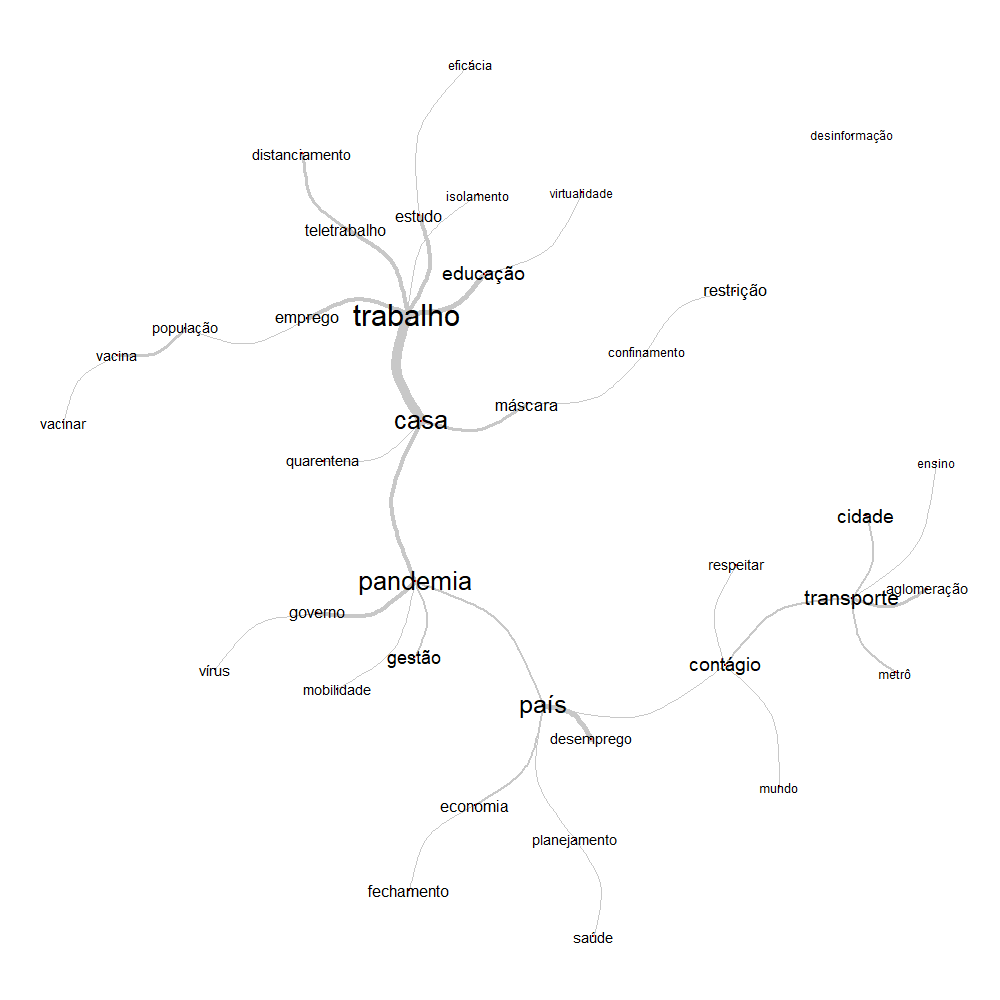
Source: The Authors
In Figure 12, they are directly related to "work (trabalho)," the word "house (casa)" appears, demonstrating the importance of housing during the period of restrictions. Furthermore, this relationship is demonstrated through the unfolding of the halo in words "education (educação)," "employment (emprego)," "quarantine (quarentena)," "confinement (confinamento)," "restriction (restrição)," "telework (teletrabalho)," "study (estudo)," and "isolation (isolamento)," as some examples. Thus, these ramifications cover aspects related to changes in daily activities with the adopted measures.
In the most central part of the graph, "pandemic (pandemia)" indicates the mentions in the speeches about the government's responsibility before management aimed at protecting the population from contamination, considering urban mobility. Following the unfolding of the graph, there is the halo where "country" is centralized, relating to "unemployment (desemprego)," "economy (economia)," "planning (planejamento)," "health (saúde)," and "closure (fechamento)," thus expressing the interviewees' view of the Colombian economy. This halo is still linked to "contagion," which, as far as it is concerned, is related to "transport (transporte)," followed by "city (cidade)," "subway (metrô)," and "agglomeration (aglomeração)." This analysis demonstrates that the interviewees mentioned the country's economic situation, which contributed to the fact that many people needed to expose themselves to contamination to maintain their living conditions.
The following tables show comparisons between the summaries of the speeches analyzed, considering each axis in studies:
Chart 5 – Comparison between the syntheses of the analyzed speeches. Axis 1: Socioeconomic
|
Axis |
São Paulo |
Medellín |
|
1. Socioeconomic |
The speeches demonstrated the conflict between the isolation measures adopted by the city hall and the concern of the interviewees with the maintenance of employment and income.
Many respondents stated that the closure of businesses and the imposed social isolation were responsible for financial difficulties for families and unemployment. |
The economic situation generated by the pandemic has contributed to high financial losses, unemployment rates, and bankruptcy of service providers, traders, and self-employed professionals. Moreover, it demonstrates that the crisis is stronger in vulnerable populations, consistent with the city's social inequalities.
In education, the loss of socialization, the difficulty of adapting to technologies, and the lack of resources to support online activities were mentioned. |
|
Summary of the speeches analyzed |
In both cities, respondents pointed out great economic difficulties arising from the restriction measures adopted by local governments, in addition to the difficulty in maintaining work and study activities remotely. |
|
Source: The Authors
Chart 6 - Comparison between the syntheses of the analyzed speeches. Axis 2: Public Management
|
Axis |
São Paulo |
Medellín |
|
2. Public Management |
The speeches showed that governments (federal, state, and municipal) should have acted more in adopting measures to combat the pandemic. However, the actions taken between the governmental spheres often conflicted with each other. |
The influence of corruption in decision-making in the fight against the pandemic was highlighted, favoring prominent entrepreneurs and financial institutions.
Government planning capacity to combat the pandemic. Needs to improve performance in restriction measures and slowness in vaccine negotiations.
|
|
Summary of the speeches analyzed |
In both cities, the discourse on the measures adopted by the rulers was characterized by improvisation and the need for more planning and direction to local characteristics and needs. |
|
Source: The Authors
Chart 7 - Comparison between the syntheses of the analyzed speeches. Axis 3: Urban Space
|
Eixo |
São Paulo |
Medellín |
|
3. Urban Space |
The parks were indicated as places with the lowest risk of contamination. The speeches also pointed out the citizens' concern with the overcrowding of public transport modes concerning the possibility of contamination with COVID-19. According to the interviewees, the city hall must manage the public transport problem more efficiently. The speeches also highlighted the isolation causing substantial psychological, physiological, and social impacts. |
The speeches showed a high incidence of words related to compliance and obedience to the rules restricting public space use. It was possible to observe that these restriction measures boosted the use of private cars and that the curfew generated more traffic and agglomerations, thus contributing to more significant contamination of people, as well as space restrictions and overcrowding of housing that make distancing physical exercise and quarantine challenging to practice (CORBURN et al., 2020).
|
|
Summary of the speeches analyzed |
In São Paulo, the interviewees pointed out more significant personal losses in the impossibility of going to parks and public areas, compared to the situation faced in public transport. In Medellín, however, the difficulty in adapting the measures to restrict public spaces was pointed out because of the economic reality its inhabitants face. In addition, a relevant conflict with the long-term measures is related to the cultural tendency of the populations to the intensive use of the public space as a meeting place, conviviality, leisure, and frequent festive celebrations. |
|
Source: The Authors
It was observed that the citizens interviewed presented opinions in agreement with the containment measures adopted locally and were willing to adhere to habits that promoted the protection of individual and collective health; they also showed concerns with the economic aspects of society. These opinions corroborate the study by Gonçalves (2017) and Bispo and Morais (2020), who point out concern for one's health as a significant predictor for voluntary engagement to follow the recommendations against COVID-19.
The investigated population of both locations showed distrust of the public power's decisions at the municipal, state, and federal levels. According to the interviewees, the policies adopted were mainly disconnected and conflicting. Ezeibe et al. (2020) comment on the importance of the role of public authorities in controlling the COVID-19 pandemic. According to the authors, corruption, lack of adequate planning, and improvisation in actions to combat the pandemic can increase the spread of the disease, increase deaths and compromise public hospitals, and undermine the population's confidence in the decision-making capacity of government officials. It may even compromise the adherence of individuals to preventive actions imposed by public authorities. Sharif and Khavarian-Garmsir (2020) observed that when citizens' trust in social institutions decreases, they may be less likely to adopt behavioral changes, directly influencing disease transmission rates.
The main socioeconomic effects of the pandemic were pointed out in places where there was a deprivation of the use of public spaces. Although extreme measures, such as the lockdown, were necessary, Poli et al. (2021) point out that strategic planning is a solution for the engagement of the population to be sustainable in the long term. Furthermore, Iwuoha and Aniche (2020) point out that measures must be taken considering all social strata since the poorest populations tend to be those with fewer resources and living in more significant social agglomeration situations.
The government measures adopted in these cities were similar, and there was no application of measures adapted and directed to their territories and socioeconomic contexts. Therefore, the importance of structuring an emergency policy that encompasses the experiences acquired to increase the resilience capacity of cities arises.
Other aspects pointed out were increased unemployment, business failures, and difficulties adapting to distance education. In this sense, the educational processes faced the challenge of their continuity in an unusual way.
The lack of digital infrastructure was also identified as responsible for the greater exposure of workers in the most critical periods of the pandemic. The difficulties of maintaining income and unemployment generated by the pandemic and isolation actions were presented by Samanca and Vargas (2020), Sharif and Khavarian-Garmsir (2020), and Iwuoha and Aniche (2020). According to the authors, those most affected by these effects were informal workers and those who could not carry out their professional activities remotely.
Throughout the pandemic, the effects on mental health in different groups were mentioned in the speeches analyzed. For schoolchildren, for example, the effect of confinement was reflected in socialization difficulties, conflicting intra-household relationships, and learning difficulties. In the city of Medellín, there have been cases of suicide that are being studied to obtain numbers that allow us to understand the dimension of the phenomenon. These behaviors were discussed by Sharif and Khavarian-Garmsir (2020). According to the authors, countries where interpersonal contact between inhabitants is a behavioral and cultural characteristic, showed great difficulties in adhering to the isolation actions imposed by health authorities.
It was observed that the cities of São Paulo and Medellín had similar views among their citizens regarding the impacts their cities suffered from the current crisis. Respondents pointed out significant losses concerning employability and small and medium-sized companies as a result of measures to restrict commercial establishments and service providers, as well as mobility restrictions imposed in cities, which contributed to the governmental measures of these cities being questioned concerning the criteria adopted since they culminated in an unwanted effect of agglomeration of public transport.
In São Paulo, it was evident, through analyses and speeches, the lack of coordination between the measures adopted between the governmental spheres. In Medellín, the highlighted concern was about corruption and improvisation in the face of the COVID-19 pandemic.
In this way, individual actions to protect against contamination appear essential because of the containment of the pandemic and the impossibility of social isolation, demonstrating a symptom of the crisis in the relationship between municipal governments and their citizens. Moreover, because they are relatively large and dense cities, the number of workers in essential services is also more significant, making it difficult to comply with social isolation determinations.
It is noted throughout this study that technology has allowed for mitigating the impacts of the health crisis on the population in general. It was also possible to see evidence of a forced digital transformation characterized by dissemination on social networks, negotiations through messaging applications, electronic payments, and deliveries through application services. This contributed to the survival of informal workers, SMEs, and supplying society during a pandemic.
However, much data, time, and resources are required to use technology in a smart city. Thus, the function of the smart city must be closely linked to local needs and available resources. As such, even if smart city technologies are readily available, they are only as effective as good hygiene practices and social distancing recommendations.
With strict mobility restrictions, delivery services grew, and online purchases were strengthened. However, the impacts felt in education were negative, with the loss of quality in remote teaching. Environmentally, there were benefits to the restrictions in the sense of reducing the emission of greenhouse gases with the stoppage of commercial and industrial activities and, on the other hand, the increase in energy consumption inside homes.
The cities studied have in common the overcrowding of public transport, the disorderly adoption of restriction measures, and the socioeconomic fragility of their societies, which may have contributed to the high rate of disease transmission. It is important to emphasize that transports that were already overloaded, with the effects of restrictions on economic activities, became targets of criticism due to their incompatibility with the imposed rules. Therefore, the restrictive measures adopted by the government resulted in different impacts among the cities studied, and the crisis mainly affected the less privileged.
Therefore, the importance of adopting and monitoring measures to contain the pandemic and adapting these measures to the different contexts of the impacted cities, considering each territory's and society's weaknesses and strengths, is perceived. Consequently, this research demonstrates the need to design urban planning solutions that allow greater access to better living conditions for the population, with greater possibilities for health protection and support for economic and educational activities in different communities. In this way, the power of resilience of cities is due, in large part, to the dynamics of cooperation and conditions of the communities, so that, then, the capacities of these communities generate social capital, thus demonstrating their possibility of survival, with the previous quality, to the extreme events such as the COVID-19 pandemic.
As a suggestion for future work, the researchers suggest the continuity of the conducted interviews; However, these are adapted to assess the post-pandemic effects and how the citizens of the cities studied (São Paulo and Medellín) assess the resumption of economic and daily activities. In order to obtain a more global analysis, other countries with a level of development equivalent to Brazil and Colombia could be prospected, which was the main limitation of this research.
ANDION, C. Atuação da sociedade civil no enfrentamento dos efeitos da COVID-19 no Brasil. Revista Brasileira de Administração Pública: FGV EBAPE. Rio de Janeiro, v.54, n.4, p 936 – 951, 2020.
BACHMAN, D. The economic impact of COVID-19. Deloitte Insights. Disponível em: https://www2.deloitte.com/global/en/insights/economy/covid-19/economic-impact-covid-19.html . Acesso em: 04/05/2022.
BANAI, R. Pandemic and the planning of resilient cities and regions. Cities, v. 106, 6p, 2020.
BISPO, J. P.; MORAIS, M. B. Participação comunitária no enfrentamento da COVID-19: entre o utilitarismo e a justiça social. Cadernos de Saúde Pública, v. 36, n.8, 9p, 2020.
CÁRDENAS, J.; ROBLES-RIVERA, F.; MARTÍNEZ-VALLEJO, D. Élites Empresariales y Desigualdad en Tiempos de Pandemia en América Latina (Business Elites and Inequality in Times of Pandemic in Latin America). Revista Española de Sociología, v. 29, n. 3, p.80 – 94, 2020.
CARTENÌ, A.; DI FRANCESCO, L.; MARTINO, M. How mobility habits influenced the spread of the COVID-19 pandemic: Results from the Italian case study. Science of the Total Environment, v. 741, 9p, 2020.
CORBURN, J. et al. Slum health: arresting COVID-19 and improving well-being in informal urban settlements. Journal of Urban Health, v.97, n.3, 10p, 2020.
DE LIMA, A. Q. O; TUMBO, D.L. Desafios do ensino remoto na educação básica em tempos de pandemia. Revista Faculdade FAMEN, v. 2, n. 1, p. 141 – 151, 2021.
MEDELLÍN, Alcaldía. Efectos económicos y sociales por COVID-19 y alternativas de política pública: un análisis para Medellín y el AMVA. Medellín: Secretaría de Desarrollo Económico, 2020.
OLIVEIRA ANDRADE, R. The Brazilian slums hiring their own doctors to fight COVID-19. Bmj Global Health, v. 369, 2020.
DEBONE, D. DA COSTA; M. V. MIRAGLIA; S. GEK. 90 days of COVID-19 social distancing and its impacts on air quality and health in Sao Paulo, Brazil. Sustainability, v. 12, n. 18, 16p., 2020.
DESAI, D. Urban Densities and the COVID-19 Pandemic: Upending the Sustainability Myth of Global Megacities, ORF Occasional Paper, n.244, Observer Research Foundation, 2020.
EZEIBE, C. C.; CHUKWUDI, I.; EZEIBE, N.; OGUONU, C.N.; NWANKWO, C.K.A.; OSADEBE, A.N. Political distrust and the spread of COVID-19 in Nigeria. Global Public Health, v. 15, n. 12, p. 1753 – 1766, 2020.
FRANCO, M.L.P.B. Análise de conteúdo. Editora Autores Associados, 96p, 2020.
GIL, A. C. Metodologia científica. São Paulo, v. 3, 2002, 220p.
GONÇALVES, C. Regiões, cidades e comunidades resilientes: novos princípios de desenvolvimento. Revista Brasileira de Gestão Urbana, v. 9, n.2, p. 371 – 385, 2017.
GUIMARÃES, R. B; CATÃO, R. C.; MARTINUCI, O. S; PUGLIESI, E. A.; MATSUMOTO, P. S. S. O raciocínio geográfico e as chaves de leitura de COVID-19 no território brasileiro. Estudos Avançados, v.34, n.99, p. 119 – 139, 2020.
IWUOHA, V. C.; ANICHE, E. T. Covid-19 lockdown and physical distancing policies are elitist: towards an indigenous (Afro-centred) approach to containing the pandemic in sub-urban slums in Nigeria. Local environment, v. 25, n. 8, p. 631 – 640, 2020.
JAMES, P. DAS; JALISINSKA, R.; SMITH, A. L. Smart cities and a data-driven response to COVID-19. Dialogues in Human Geography, v.10, n.2, p255–259, 2020.
JOHNS HOPKINS UNIVERSITY. Coronavirus COVID-19 Global Cases by Johns Hopkins CSSE [Internet]. Johns Hopkins University; 2020. Disponível em: https://coronavirus.jhu.edu/map.html. Acesso em March 7th. 2022.
KUMMITHA, R. K. R.; CRUTZEN, N. How do we understand smart cities? An evolutionary perspective. Cities, v. 67, p. 43 – 52, 2017.
LARA, L. M. R; CRUZ, N. C. M. Retos e implicaciones en seguridad y salud en el trabajo en la modalidad de trabajo en casa, como respuesta en tiempos de pandemia por COVID-19 en Colombia. 2021, 115p. Dissertação (Mestrado em Segurança e Saúde do Trabalho). Pontificia Universidad Javeriana, Bogotá, 2021.
MACIEL, J. A. C; SILVA, I. L. C; FARIAS, M. R. Análise inicial da correlação espacial entre a incidência de COVID-19 e o desenvolvimento humano nos municípios do estado do Ceará no Brasil. Revista Brasileira de Epidemiologia, n.23, 17p, 2020.
MATIAS-PEREIRA, J. Manual de metodologia da pesquisa científica. Grupo Gen-Atlas, 2016, 224p.
MOLINA-BETANCUR, J; MARTINÉZ-HERRERA, JMP; BENACH, J. Coronavirus disease 2019 and slums in the Global South: Lessons from Medellín (Colombia). Global Health Promotion, v.28, n.1, p.65-69, 2021.
ORTIZ, S.G.; GONZÁLEZ, E.J.M.; GARCÍA, G.A. Análisis espacial de la informalidad laboral intraurbana en Medellín. Sociedad y Económia, n.35, p. 9-31, 2018.
PEREIRA, A. K; OLIVEIRA, M. S; SAMPAIO, T. S. Heterogeneidades das políticas estaduais de distanciamento social diante da COVID-19: aspectos políticos e técnico-administrativos. Revista de Administração Pública, v.54, n.4, p.678-696, 2020.
PEREIRA, A.S.; SHITSUKA, D.M.; PARREIRA, F.J.; SHITSUKA, R. Metodologia da pesquisa científica. Universidade Federal de Santa Maria, 2018, 119p.
POLI, A.; GEMIGNANI, A.; CONVERSANO, C. The psychological impact of SARS-CoV-2 quarantine: observations through the lens of the polyvagal theory. Clin. Neuropsychiatry, v. 17, p. 112-114, 2020.
RAJAN, D; KOCH, K.; ROHRER, K.; BAJNOCZKI, C.; SOCHA, A.; VOSS, M.; NICOD, M.; RIDDE, V.; KOONIN, J. Governance of the Covid-19 response: a call for more inclusive and transparent decision-making. BMJ Global Health, v. 5, n. 5, 8p, 2020.
SALAMANCA, J. D. G.; VARGAS, G. Quarantine and Informality: Reflections on the Colombian Case. Space and Culture, v. 23, n. 3, p. 307-314, 2020.
SCHREIBER, M. Coronavírus: uso de dados de geolocalização contra a pandemia põe em risco sua privacidade? BBC News Brasil, Brasília, 21 de abril de 2020. Disponível em: https://www.bbc.com/portuguese/brasil-52357879 Acesso em: 05 maio de 2022.
SHARIFI, A.; KHAVARIAN-GARMSIR, A. R. The COVID-19 pandemic: Impacts on cities and major lessons for urban planning, design, and management. Science of The Total Environment, v.749, 2020.
SOUZA, M.A.R; WALL, M.L.; THULER, A. C. M. C.; LOWEN, I.M.V.; PERES, A.M. O uso do software IRAMUTEQ na análise de dados em pesquisas qualitativas. Revista da Escola de Enfermagem da USP, v. 52, 7p., 2018.
STOROPOLI, J. E.; SILVA NETO, W. L. B; MESCH, G. S. Confidence in social institutions, perceived vulnerability and the adoption of recommended protective behaviors in Brazil during the COVID-19 pandemic. Social Science & Medicine, v.265, n.1982, 8p., 2020.
TAQUETTE, S. R.; BORGES, L. Pesquisa qualitativa para todos. Editora Vozes, 2021, 208p.
TRINDADE, E.P.; MEZZAROBA, M.P.; CARNEIRO, M.R.; FIALHO, F.A.P. E-gov. como ferramenta de governança para cidades inteligentes, um estudo de casos entre Brasil e Colômbia. Revista Ciencias de la Documentación, v.3, p. 44-55, 2017.
VELAVAN, T. P. MEYER; C. G. The COVID-19 epidemic. Tropical Medicine and International Health, v.25, n. 3, p. 278-280, 2020.
YIN, R. K. Case study research and applications: Design and methods. Sage publications, 2017.
ZHONG, BL; LUO, W.; LI, HM; ZHANG, QQ; LIU, XG; LIN, WT; LI, Y. Knowledge, attitudes, and practices towards COVID-19 among Chinese residents during the rapid rise period of the COVID-19 outbreak: a quick online cross-sectional survey. International journal of biological sciences, v. 16, n. 10, p. 1745-1752, 2020.